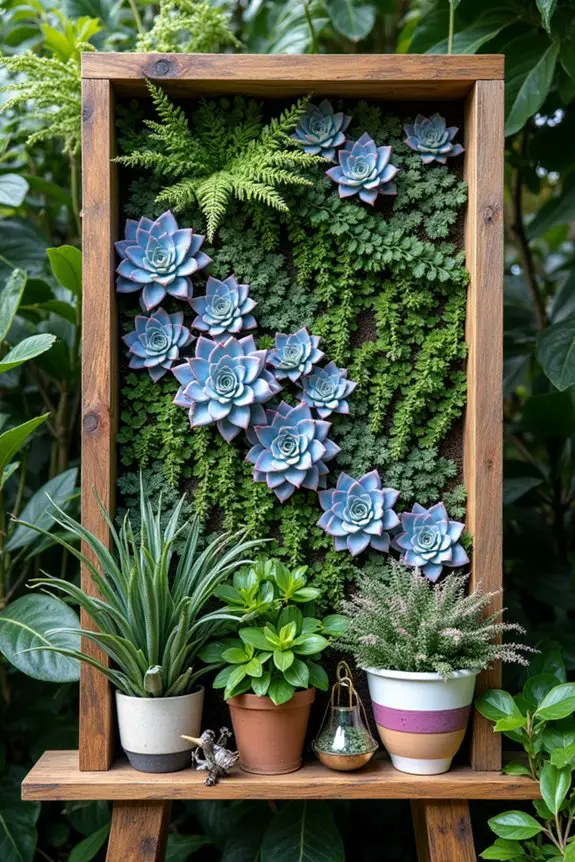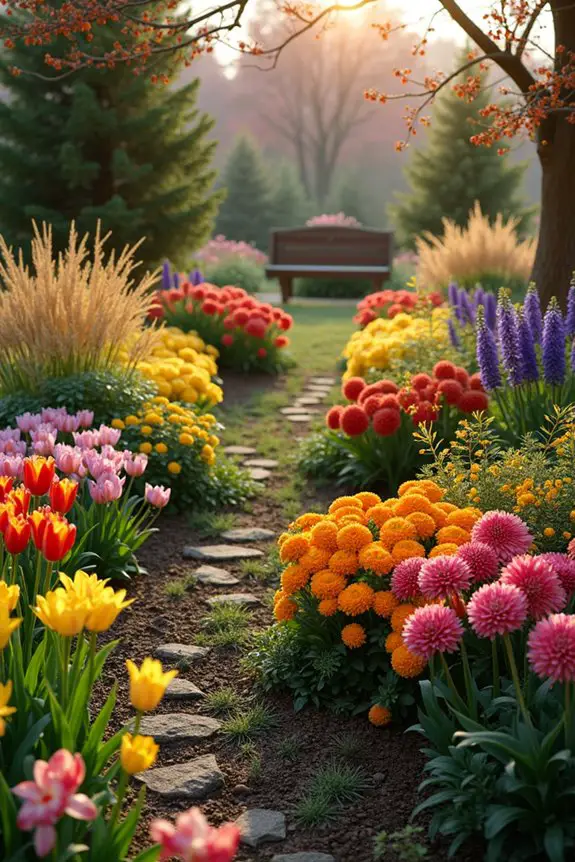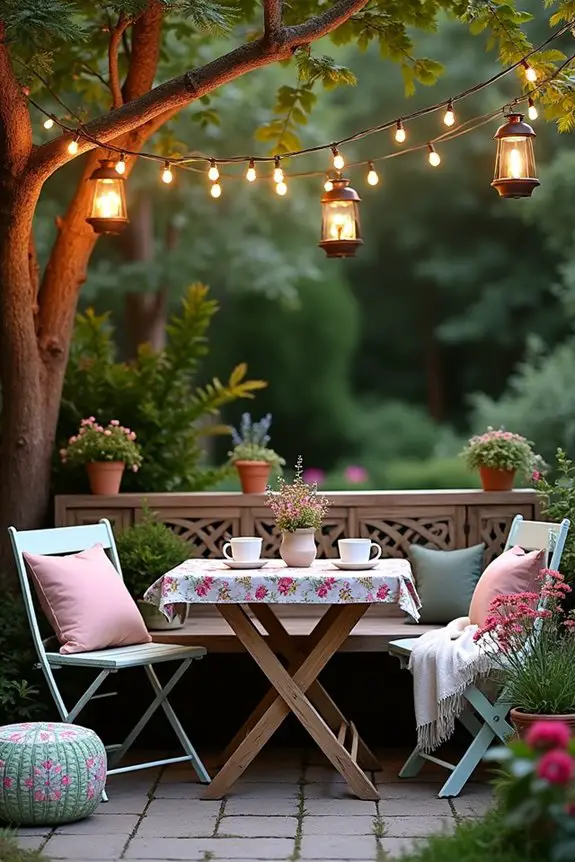Imagine transforming your backyard into a tranquil haven using stunning garden wall designs. You know, those vertical gardens that make you feel like you’ve stepped into a lush jungle? Picture cascading greenery, vibrant colors, and maybe a playful touch of art. It sounds dreamy, right? But where do you even start? Let’s explore some creative ideas and practical tips that can turn your outdoor space into a personal retreat, or at least a spot where you can sip your coffee without eyeing that overgrown hedge.
Vertical Garden Wall Ideas
When you think about vertical garden wall ideas, what comes to mind?
Picture a lush, green masterpiece right on your wall, filled with stunning textures and colors that could brighten any space.
It’s all about blending biophilic elements, choosing eco-friendly materials, and arranging those plants with a flair that says, “I’ve got this” — even if you feel like your last houseplant just judged you for overwatering it.
1. Biophilic Elements Integration
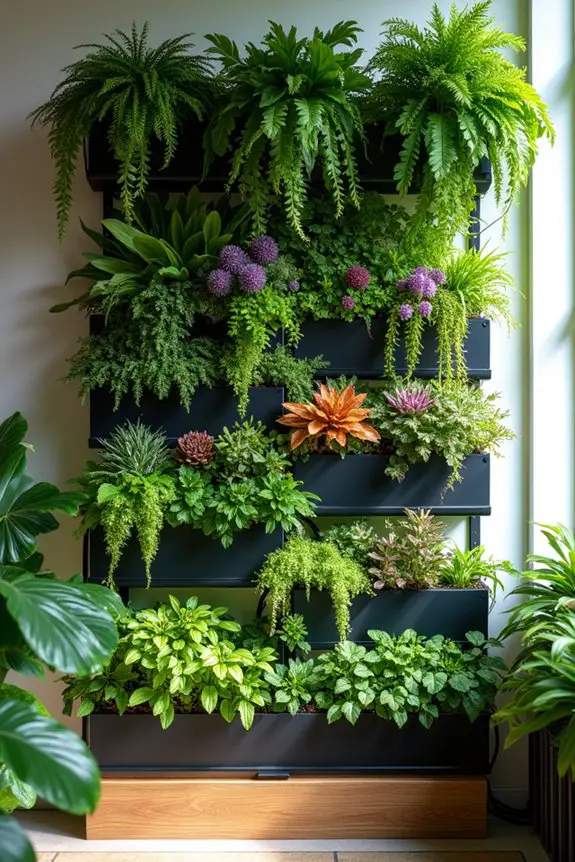
When it comes to garden wall designs, integrating biophilic elements can truly breathe life into your space. Imagine a vibrant vertical garden wall, blooming and thriving—a slice of nature that not only beautifies but also invigorates the air you breathe. It’s a win-win for functionality and style!
Think about it: a living wall serves as a unique focal point, drawing eyes and sparking conversations. Plus, it’s perfect for those of us who might be short on ground space. You get to enjoy the lush greenery without needing a massive backyard. And let’s face it, who doesn’t want to feel like they’ve got a mini jungle in their home?
To start your own vertical garden wall, select a sturdy wall that gets enough light. Then, grab some modular planters or wall-mounted pockets; those sleek guys are easy to hang and allow for proper drainage—no one likes soggy roots! Utilizing an effective precision seed dispenser can ensure your chosen plants thrive as they receive the right amount of seeds in your vertical setup.
Now, choose plants that thrive in vertical settings, like ferns, ivy, or even some colorful succulents. If you’re feeling brave, mix and match to create an eye-catching display. Additionally, installing smart plant sensors can help you monitor the moisture levels and ensure your wall garden stays healthy and vibrant.
Once you’ve got your plants ready, install your planters in a manner that creates an appealing pattern. Aim for varying heights and colors; it’ll keep things interesting.
Watering can be a bit of a challenge, so consider a drip irrigation system if you’re all about that low-maintenance life. Or, just embrace the occasional splash and enjoy a revitalizing mist while tending to your plant pals.
And remember, it’s all about finding joy in the process! Don’t stress over perfection. Some of my plants might resemble sad little green noodles at times—hey, we all have our off days.
2. Eco-friendly Material Choices
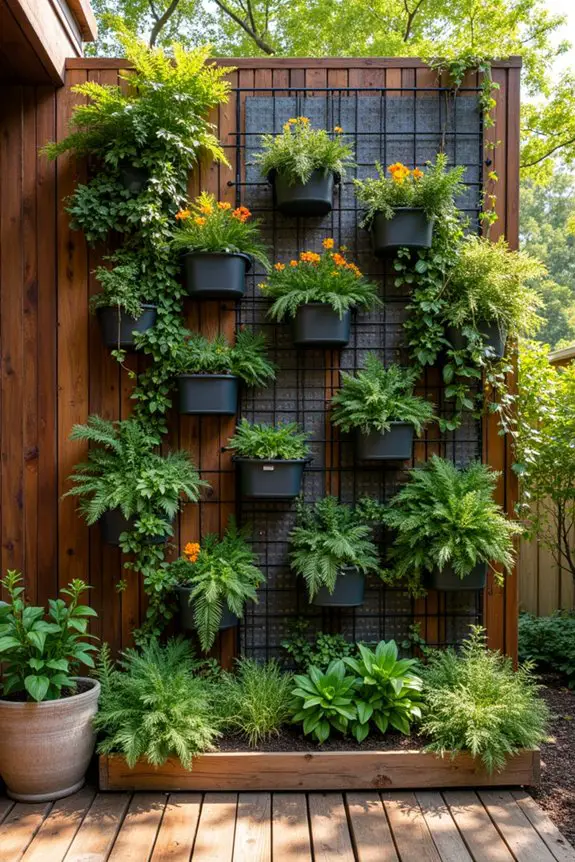
When designing a vertical garden wall, choosing eco-friendly materials is a brilliant way to show love for the planet while creating a stunning aesthetic. Not only do these materials help your garden thrive, but they also add a touch of sustainability, making you feel like a true earth hero. Plus, who doesn’t love decking their space with guilt-free style?
Let’s explore some awesome material ideas. Start with recycled materials; think old pallets or reclaimed wood. Not only is this budget-friendly, but it also lends a rustic charm that pairs beautifully with vibrant greenery. You can create a unique backdrop for your plants, and every time you glance at it, you’ll feel that warm glow of making a positive impact.
Another fantastic option is using biodegradable planters made from bamboo or coconut coir. They’re kind to the earth and add a natural look to your installation. And here’s a fun tidbit: as these planters break down, they nourish your plants. It’s like giving your garden a little organic snack every now and then. Using a soil scoop garden can further help you effectively transplant your plants into these eco-friendly containers.
For the structure itself, consider using repurposed metal grids or chicken wire. Not only do they provide sturdy support for your climbing plants, but they’ll also develop a rustic, industrial vibe that can look quite chic. Plus, it means less plastic waste crowding landfills. It’s a win for both style and sustainability.
And don’t forget about your soil choice! Opt for organic potting soil; it’s free of harmful chemicals and will allow your plants to flourish. You can even add things like worm castings or compost to maximize the nutrient game, as worm castings are a rich source of nutrients for your plants. Because honestly, who wouldn’t want their plants to live their best lives right next to you?
Building a vertical garden wall with eco-friendly materials isn’t just a project; it’s a fun journey. The satisfaction of contributing to a green world while creating a space that glows with life is unmatched. Every time you pass by your creation, remember, you’re not just nurturing plants—you’re nurturing the planet too.
3. Textured Wall Finishes
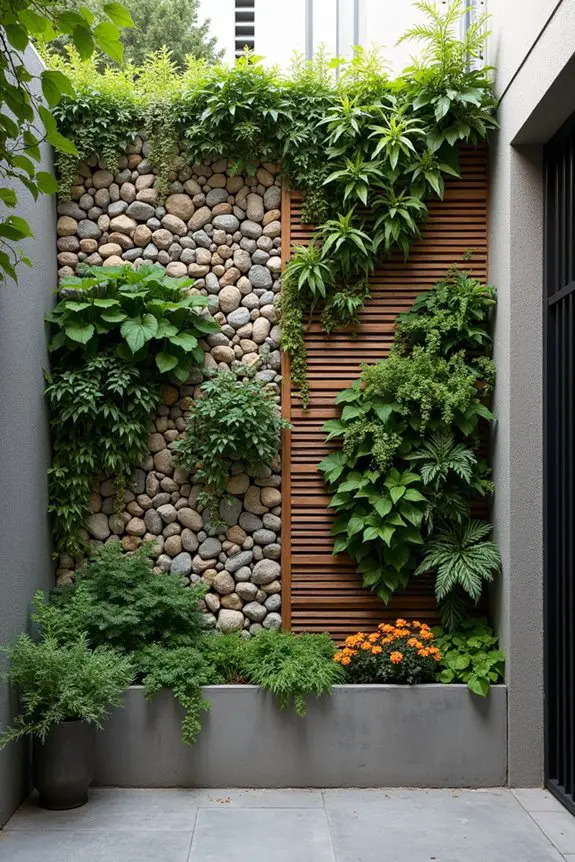
When it comes to designing a vertical garden wall, adding textured finishes can really amp up the style and functionality. Imagine the lush greenery juxtaposed against a rough-hewn surface—it creates this vibrant dynamic that beckons visitors to come closer and admire. Plus, textured surfaces can help with moisture retention, which is always a bonus for your plant friends.
Let’s explore some great ideas for textured wall finishes. One adorable approach is to use natural stone. Picture smooth river rocks or rugged slate arranged like a cozy puzzle piece. The tactile quality not only feels lovely but also provides a solid base that won’t fall apart under the weight of climbing plants. Talk about sturdy vibes.
If you’re feeling adventurous, how about trying textured concrete? You can create a raw, urban aesthetic that pairs so nicely with greenery. Reflect on stamping your concrete with patterns or even using a specific color to give it a pop of personality. Just be sure to seal it, so it holds up in outdoor conditions. Because, trust me, nobody likes a crumbling wall.
Another fun layer to reflect on is using wooden slats. You can create a lovely texture by arranging them in different sizes—like the way a jigsaw puzzle keeps you engaged. This not only looks rustic but can also provide varying levels for plants to cling to and grow. It’s like giving your plants their very own climbing gym, all while you get that warm woodsy feel.
Don’t forget to check how water will flow and drain. Sometimes texture can interfere with proper drainage if you’re not careful. So, if your wall is bubbling with creative surfaces, make sure you include pockets or channels that can guide excess moisture away.
You want your plants to thrive—not swim.
Textured finishes bring depth to your vertical garden wall that you just can’t achieve with flat surfaces. It’s all about balancing that beauty with a touch of practicality. Moreover, incorporating elements like UV grow light sterilizers can enhance plant health by reducing pathogens and promoting growth. So, as you weigh your options, think about how the texture can show off your plants while also keeping them safe and happy. It’s the art of blending nature with your personal flair.
Who knew gardening could feel so creative?
4. Color Palette Selection
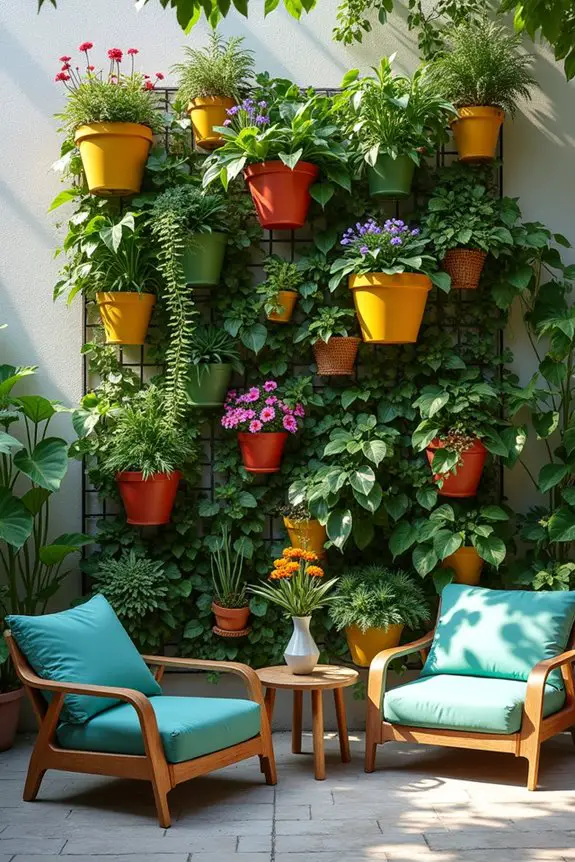
When diving into the creation of a vertical garden wall, selecting the right color palette is like picking the perfect outfit. It sets the mood, showcases your plants beautifully, and gives your space personality. A well-thought-out color scheme not only enhances the visual appeal but also harmonizes the overall vibe of your garden, making it a serene retreat.
First things first, consider what colors speak to you. Are you drawn to calming greens and earthy tones? Or perhaps you’re more about vibrant hues that scream for attention? Choose a base color—something neutral like soft gray or white works wonders. It allows the lush greens of the plants to pop right off the wall, creating a stunning contrast. Think of it as wearing a white shirt to make that bold necklace shine.
Next, how about adding accents? This could be through colorful pots, plant selections, or even the wall itself. If you’re feeling cheeky, experiment with unexpected colors like vibrant purples or sunny yellows that coordinate with seasonal blooms. Just picture a bright flower against a muted background; it’s like life in 3D.
Plus, have fun mixing textures and colors for a funky look that keeps the eye dancing around—think of it as an art piece, but with living components.
An aspect many overlook is how the color scheme can affect your plants’ growth. Yep, you heard that right. Dark colors can absorb heat, while lighter ones may reflect light. So, if you’re planning to grow sun-loving succulents, consider a lighter palette to keep them cozy and thriving. It’s amazing how thoughtful choices can lead to happy plants—and a happy gardener.
To make sure your vision doesn’t end up being a color clash, create a swatch board. Grab some paint chips or fabric in your chosen colors and lay them out together. This way, you can see how they work in harmony. If they look like they’re fighting at a family reunion, it’s time to rethink.
At the end of the day, remember that choosing a color palette is all about expressing yourself and creating a relaxing space. If you love it, that’s what counts. Don’t rush the process; take your time and enjoy it. Who knew gardening could be so colorful?
5. Symmetrical Plant Arrangements
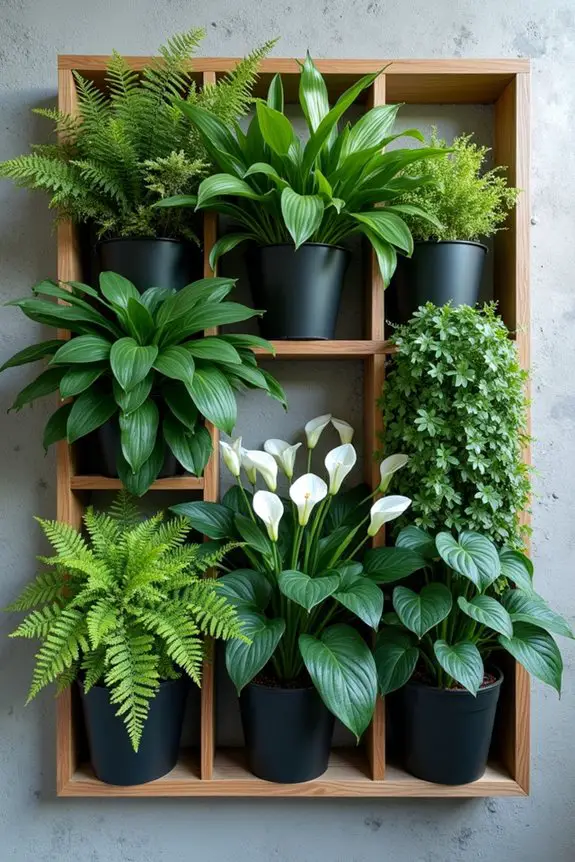
Creating a vertical garden wall with symmetrical plant arrangements is like finding the perfect balance in your favorite dish—it just feels right. This idea not only enhances the overall aesthetics of your garden but also brings a sense of harmony and order to your space. Symmetry can make an area feel calm and inviting, as it appeals to our natural desire for balance.
So, how do you create this magical symmetry? Start by selecting a few plants that have similar growth habits or even similar sizes. This could be two or three types of plants that you plant in matching pots. Think of it like pairing the right shoes with your outfit. For instance, if you have a lush green fern on one side, try to mirror it with a similar-sized plant on the other side—like a charming pothos or an adorable peace lily.
As you arrange your plants, keep in mind the heights. Taller plants should anchor the ends, while medium-sized foliage fills the middle. Picture a layered cake where each layer is just the right height, making it visually delightful.
Another neat trick? Try using the same pots or containers to reinforce that symmetry. It’s kind of like wearing matching socks—you mightn’t always think about it, but it does clue your observers into a cohesive look.
Don’t forget about the background. A plain wall can accentuate your beautifully arranged plants, so stick with something that complements your color palette while allowing your green buddies to shine. If you painted it a soft gray, for instance, your vibrant plants will pop like stars in a night sky.
In my experience, keep it simple and tidy. Nothing says “yeah, I got this” better than a well-balanced plant arrangement. If you’re like me, you might feel tempted to go wild with all the plants you love, but trust me, less is sometimes more.
Embrace that sense of order, and let those symmetrical vibes transform your space into an oasis of beauty and peace. You’ll thank yourself later when everything looks effortlessly chic—like you just stepped out of a gardening magazine, even if you wore your paint-stained sweats while doing it.
6. Layered Plant Grouping
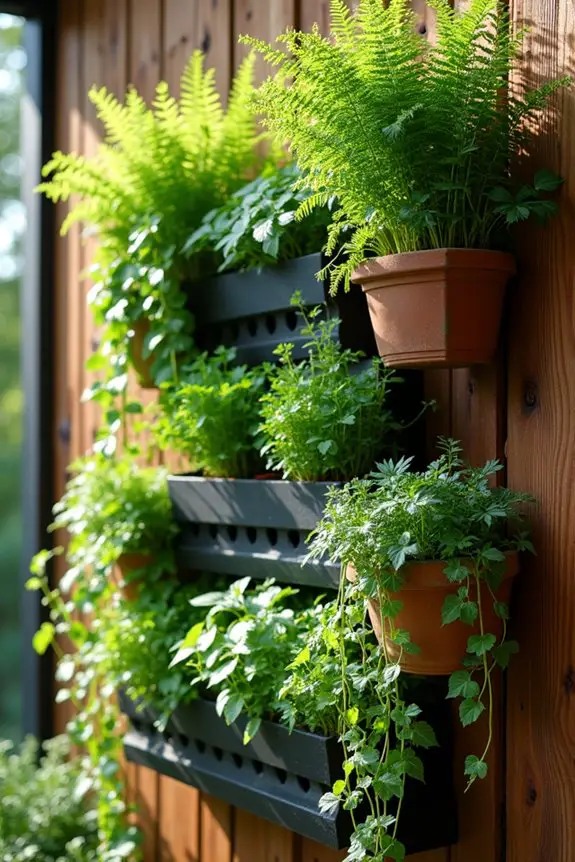
Creating a stunning vertical garden wall with layered plant grouping is like crafting a beautiful lasagna—each layer adds flavor and depth, making the whole thing more delightful. Not only does this method make your space pop visually, but it also provides your plants with the chance to thrive at various levels, maximizing sunlight and air circulation. Plus, who doesn’t love the lush, full look of greenery cascading down a wall?
So, how do you build this deliciously layered plant masterpiece? Start by choosing plants of different heights and sizes. Think tall, leafy ferns at the top, medium-sized herbs in the middle, and trailing vines like string beans or ivy dangling down. It’s a bit like stacking your favorite books—some big, some small, but all working together to create a cozy little library.
When arranging your plants, consider how light hits them. The taller plants crave more sun, while the shorter guys appreciate a little shade. This strategically planned layering guarantees that every plant gets a chance to thrive, like making sure every layer of your lasagna has the right amount of cheese.
Don’t forget to vary your leaf shapes and colors—this adds visual interest, kind of like adding different spices to a dish to elevate the flavor.
An essential tip? Use a good quality potting mix with great drainage. No one wants a soggy plant; it’s like overcooking pasta—nobody enjoys that mushy texture. Layering also makes it easier to create a little drip tray beneath your wall, which will catch any excess water. This way, you won’t accidentally turn your beautiful garden wall into a swamp.
Finally, take a step back and admire your creation. You’ll feel like a gardening ninja, even if your hands are covered in dirt and your shirt may or may not have a few mystery stains. It’s all part of the process.
With layered plant grouping, your vertical garden wall can transform into a lush oasis that not only looks fabulous but also brings joy and tranquility. And remember, keep it fun. After all, gardening is just a really fancy way of playing with dirt.
7. Seasonal Plant Rotation
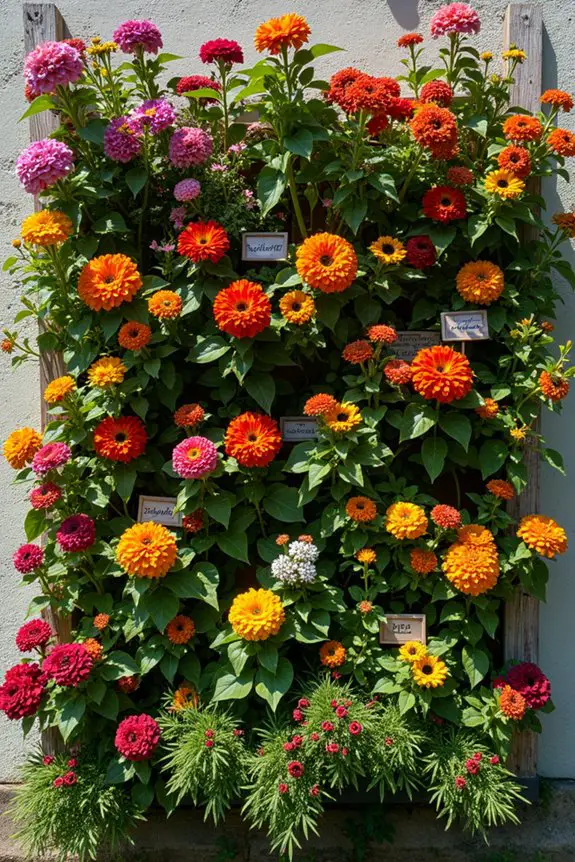
Seasonal Plant Rotation is one of the best ideas for keeping your vertical garden wall fresh and exciting throughout the year. Not only does it guarantee that your plants are thriving in their peak seasons, but it also lets you play around with colors and textures, giving your space a whole new vibe.
You can think of it like changing your outfits based on the season—fresh looks keep things lively and fun, plus who doesn’t love a good wardrobe update?
First things first, you want to plan a lineup of plants for each season. Spring is the perfect time to showcase cheerful blooms like petunias or pansies, while summer can be all about those bold colors with zinnias and sunflowers.
Then, as fall rolls around, it’s time to bring in some warm tones with marigolds or ornamental peppers. Finally, winter doesn’t have to be drab; think about using evergreens or even colorful berries that add a pop of joy to the gray days.
To make rotation easy, label your plants with their seasonal identities. Use simple tags or even sticky notes (just don’t get carried away—they can look a little messy). This way, when the seasons change, you’ll know exactly what to swap out, like having a cheat sheet for your garden.
Speaking of cheat sheets, keep a little gardening journal with notes on what worked well and what didn’t. You’ll thank yourself later when you find yourself knee-deep in mud, debating whether or not that one plant performed well last year.
When it’s time to change things up, gently remove the outdated plants and refresh the soil in their spots. Just like cleaning your fridge out before making pasta—no one wants old leftovers ruining the new deliciousness.
Then, pop in your gorgeous seasonal choices, ensuring they get enough light and water. Keeping a consistent watering schedule is essential here—kind of like remembering to check on that pasta boiling away.
As you flip your garden wall for the season, be sure to enjoy the transformation. You might feel like you’re hosting your own little plant party, inviting new friends into your life and saying goodbye to others.
It can be a bit messy and chaotic, but remember, it’s all part of the gardening adventure. Seasonal Plant Rotation can make your vertical garden wall a delightful and ever-changing masterpiece that brings you joy and satisfaction all year long.
8. Creative Plant Placement Techniques
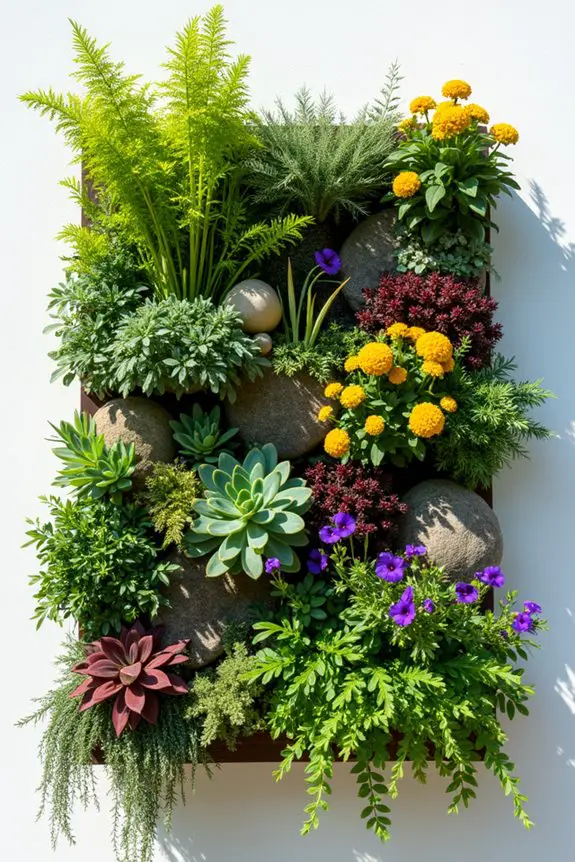
When it comes to vertical gardening, the way you place your plants can make all the difference. It’s not just about cramming them into pockets or stacking them; it’s about creating a visual feast that draws your eye and complements your space. Think of your vertical garden wall as a work of art—each plant is a brushstroke that adds color, texture, and life to your masterpiece.
One creative technique is to group plants with similar needs together. This way, you’re not just following the rules of water and light requirements; you’re also creating a harmonious look. It’s like making a smoothie: you want to blend flavors that go well together. Picture lush ferns snuggling up with vibrant, flowering plants. It’s both functional and visually stunning, like a perfectly arranged charcuterie board.
Another fun idea is to mix heights and textures. Imagine if you’d a stack of books, all piled up with wobbly adventure novels and beautiful coffee table books. You want that same kind of fun in your vertical garden.
Use taller plants at the back or top, gradually shifting to shorter ones that spill gracefully over the edges. This layering effect not only makes your garden wall interesting to look at but also guarantees that all your plants get to soak up the sunlight they deserve—because nobody likes being left in the dark, right?
Oh, and don’t forget about color coordination. When you choose plants that complement or contrast with each other nicely, your vertical wall can become a playful color burst. It’s like picking out the perfect outfit—you might want to clash a little, or go bold with bright colors, but either way, you should feel confident about your choices.
Consider using plants with different leaf shapes and colors, like variegated ivy next to deep green succulents. Visual rhythm, it’s everything!
You can also encourage a sense of adventure by incorporating trailing plants into your design. Think of them as the dramatic flair of your vertical design. Plants like string of pearls or creeping thyme hang down beautifully, creating a soft cascade that brings depth and fun. It’s like having a magical waterfall of greens right at home. Seriously, who wouldn’t want a mini jungle vibe?
In the end, creativity in plant placement is about letting your personality shine through your garden wall. Whether you keep it sleek and streamlined or wild and whimsical, make certain it reflects your style.
Just like in cooking, don’t be afraid to experiment and play around. If something doesn’t turn out quite right, it’s all part of the learning process—and who knows? You might stumble upon your own unexpected masterpiece. So, grab those pots, think outside the box, and let your garden wall tell your unique story.
9. Cascading Plant Layout Techniques
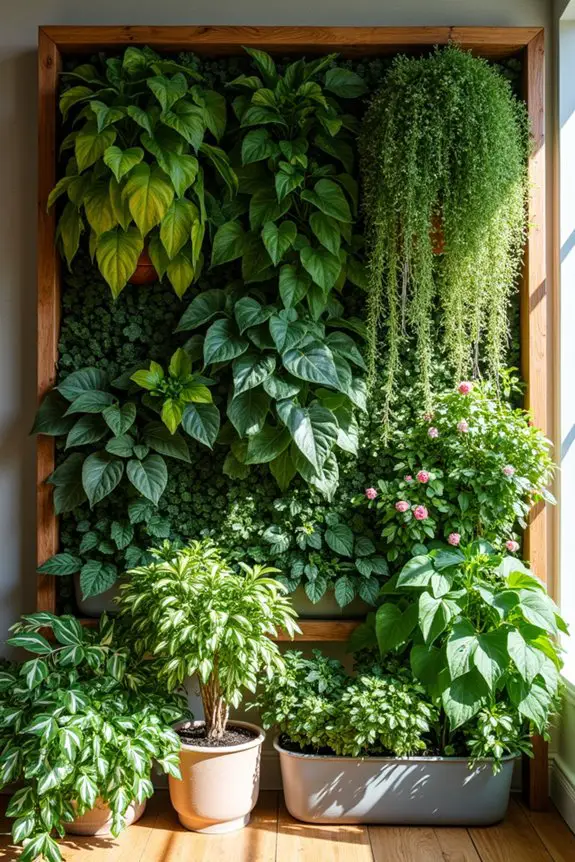
When dreaming up your vertical garden wall, think of cascading plant layouts as the dazzling dessert after a satisfying meal. It’s both functional—helping with light accessibility and plant health—and visually enchanting, like a waterfall of greens right in your living space. Just picture it: vibrant plants spilling over the edge, creating a lush, layered look that’s irresistible to the eyes.
To get off to a fantastic start, choose plants that naturally trail. You’ve got options like string of hearts, creeping jenny, or even the lovely pothos. These plants are like the whipped cream on a pie—playful and overflowing. Plan your layout so these beauties hang gracefully over the edges, while sturdier plants take center stage. Think of them as your main course that brings all the flavors together.
Now, let’s get playful with height. Start with your tallest plants at the back or the top of the structure; this forms a lovely foundation. It’s like a tiered cake—each layer is important! Gradually, as you move down or forward, choose shorter varieties to fill in the gaps. These little ones will complement the showstoppers, but they’re sneaky; they’ll be the ones that create the delightful spillover effect.
And, hey, don’t forget about variety. Mixing the textures and colors is essential. You want your cascading layout to look like a patchwork quilt of greens! Go wild with shades of leaves; think deep emerald, bright lime, or even silver-tinted plants like ‘Silver Falls’ Dichondra. It’s a feast for the eyes!
When it comes to care, remember to check the watering needs of each layer. The top tier might need more moisture than the bottom, depending on sun exposure. It’s just like how some people need a little extra sauce on their pasta—keep an eye on their thirst.
Ultimately, cascading layouts add movement and drama to your vertical garden wall, intriguing folks who walk by. They connect the space, creating a vibrant flow that feels almost alive, like a cozy gathering of friends at your dinner table.
10. Artistic Pattern Compositions
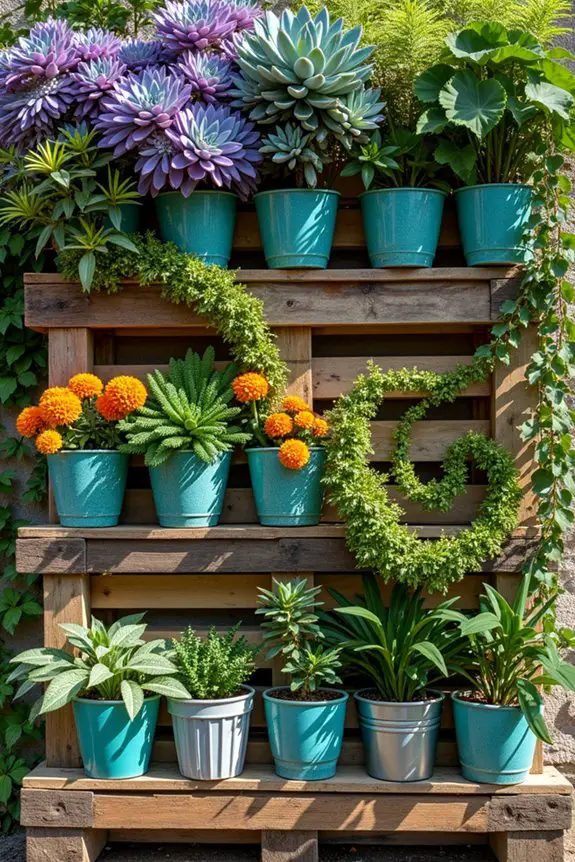
When it comes to vertical garden walls, artistic pattern compositions can be the showstopper you never knew you needed. They’re like the perfect garnish on a beautifully plated dish—delightful and eye-catching. With cleverly arranged plants, you can create everything from geometric designs to whimsical spirals, filling your space with energy and personality.
Let’s talk placement: start with your canvas. Whether it’s a wooden pallet, a metal grid, or a freestanding frame, the background sets the stage. Picture your plants as the actors, and trust me; they want to shine. Choose a mix of colors and sizes so each plant can play its part. For example, bright blues and purples can highlight greens, much like a pop of lemon zest in a rich cake.
Now, think about patterns. You could go for stripes, checkerboards, or even swirly shapes. It’s like decorating a cake with colorful icing—each layer and design creates a delicious visual treat. If you love symmetry, match similar plant types across your wall.
Or, if you’re feeling adventurous, mix textures and heights to create an organic look. Imagine planting trailing succulents next to tall ferns—talk about a party in the garden!
And don’t forget about the details. Adding unique planters or garden art can enhance the vibe even more. A funky, multicolored pot here, a sleek, modern planter there, et voilà—the wall gains character faster than you can say “herbs and heirlooms.”
It’s like giving your space a new wardrobe; suddenly, everything feels refreshed and stylish.
Remember to contemplate sunlight and watering as you design your masterpiece. Some of your plants might need a little extra love, while others are more laid-back, like those friends who are always down for pizza night. Arrange your plants based on their needs—put thirsty ones in the sun’s spotlight while the low-maintenance pals chill in the shade.
Ultimately, artistic patterns on a vertical garden wall can transform any space from drab to fab. So, grab your plants, get creative, and enjoy the process. Who knew gardening could feel so much like crafting a culinary delight? Happy planting!
Maintenance Scheduling Essentials
Maintaining your garden wall isn’t just about keeping it pretty; it’s like giving your plants their daily vitamins. You need a schedule to keep it all in check, just like you wouldn’t skip breakfast—who wants that?
Start by inspecting the wall each season: check for cracks or loose stones. Use waterproof sealants when needed, and don’t forget to wash off dirt and grime, because nobody likes a dusty wall.
As for those garden wall ideas, consider seasonal plant changes; switch things up for a fresh look!
And remember, pruning is key. You can’t let your wall get overgrown. So, grab those pruning shears, set a reminder in your phone, and let’s keep that sanctuary of yours thriving and fabulous.

